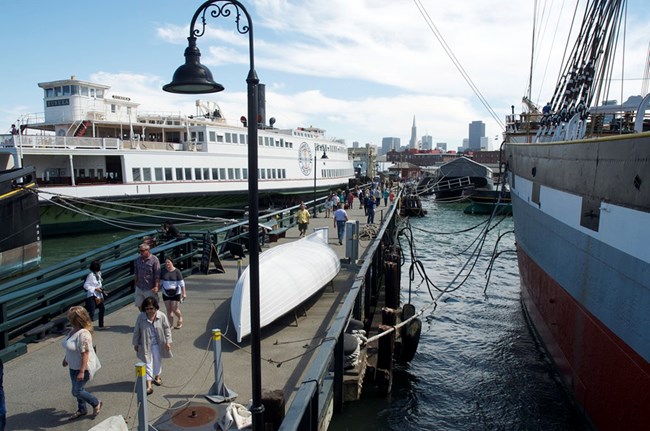Last updated: January 10, 2024
Article
Environmental Impacts of Vessel Operations

Passenger vessels (e.g., ferry boats, guided water tours, airboats, and cruise ships) allow park visitors to experience National Park Service (NPS) resources that would otherwise be hard to reach. Ferry operations provide visitors with interpretation in and around many parks including Golden Gate National Recreation Area, Channel Islands National Park, Statue of Liberty National Monument, Cape Lookout National Seashore, Dry Tortugas National Park, Isle Royale National Park, and Glacier Bay National Park. Like other modes of transportation, passenger vessels impact their environment.
Invasive Species
Invasive species come in all shapes and sizes. Noxious weeds, feral cats, and insects are all considered invasive species and challenge ecosystems in different ways. Aquatic invasive species or “hitchhikers” pose a significant threat to the ecosystem they are introduced into. Marinas and docks are just some hot spots for aquatic hitchhikers. Passenger vessels can introduce invasive species and accelerate their presence from one spot to the next. For vessels and watercraft that move from one body of water to another, proper cleaning steps must be taken to avoid of the spread of invasive species. To learn about the aquatic invasive species in your area, visit InvasiveSpeciesInfo.gov/aquatic.
Vessel Strikes
A vessel strike is any type of collision between any type of boat and a marine animal. Species like whales and sea turtles are most vulnerable to vessel strikes because they come to the surface to breathe. A vessel strike causes serious injury or death to marine life and can cause damage to the vessel or people on board. Learn more about vessel strikes and ways to prevent them at NOAA.gov, as well as keeping the following four things in mind:
-
Be alert and keep an eye out for signs of wildlife (e.g., blows, dorsal fins, wings, etc.)
-
Keep speed low in areas of known wildlife occurrence
-
Stay at least 100 yards away from wildlife when possible
-
Wear polarized sunglasses, if possible, to better detect wildlife in the water.
Vessel traffic can cause habitat degradation that impacts larger marine animals’ food sources. The changes to their environment caused by vessels and human activity cause a change in animal behavior and migration patterns.
Vegetation Impacts
When ferries enter and exit marinas and piers, anchor, or otherwise cause movement near the shore, the ecosystem is disrupted. Mud and vegetation are disturbed which can lead to the overgrowth of algae and the destruction of the natural habitat. The shallow underwater meadows hold onto carbon and support the habitat with nutrients, shade cover, and food for aquatic life. The effects of emissions released from passenger vessels into the environment cause an increase in the amount of dissolved carbon in the ocean, making seawater more acidic. This process is called ocean acidification and has negative impacts on small organisms that play a big part in the ecosystem like coral reefs, mussels, and small crustaceans. The addition of native plants in and around the marina boosts biodiversity and helps the ecosystem remain healthy. Plants remove carbon dioxide and mitigate the impacts on the environment. When ferry boats release carbon dioxide and other greenhouse gases, trees, and native plants (on land and in water) act as a filter to mitigate the environmental impacts in the area.
Fuel and Oil Spills
Large passenger vessels hold fuel and oil and must be managed properly to avoid spills that harm the environment, wildlife, and humans. To avoid fuel and oil spills, concessioner staff should have standard procedures and knowledge on how to fuel the vessel:
-
Know how much your fuel tank holds
-
Determine how much fuel you will need before filling up
-
Never top off the tank
-
Make sure anyone fueling the boat knows which deck fill is for fuel
-
Replace the deck fill cap with a color cap so it is easy to distinguish from the water or other deck fills.
In case of a spill, all vessels must be equipped with a spill response kit. This kit may include absorbent pads and socks, personal protective equipment (e.g., gloves, goggles, etc.), and a container and bags for soiled items. Spill kits differ based on the aquatic environment, to learn more about spill prevention and planning, visit EPA.gov.
Grey Water Discharge
Ferry boats generate waste like sewage and greywater. Greywater consists of wastewater from bathroom and kitchen sinks, bathtubs, water fountains, and wash basins. While this wastewater sounds much less harmful than sewage, greywater still poses a threat to the environment when discharged. Greywater contains oils, detergents, heavy metals, and fecal particles. Greywater has the potential to spread pathogenic bacteria, deplete oxygen, and increase nutrient levels in the environment, harming the ecosystem and marine life. The Environmental Protection Agency (EPA) has found that greywater can contain contaminate levels similar to domestic raw sewage. Visit EPA.gov to see frequently asked questions about vessel sewage. Greywater impacts can be reduced by:
-
Using water saving devices like low-flow sinks and shower heads
-
Researching and choosing non-toxic cleaning products for your vessel
-
Using sink strainers to catch food and debris before it enters the greywater tank
-
Maintaining holding tanks in good condition and pumping them out onshore.
It is illegal to discharge raw sewage into the ocean. Greywater on the other hand is regulated differently depending on the type of vessel. For recreational vessels, there are currently no federal rules in place for greywater. Concessioners should comply with their concessions contract and local laws and regulations pertaining to greywater and sewage discharges.
